Kung Pao Chicken 🐓 宮保雞丁
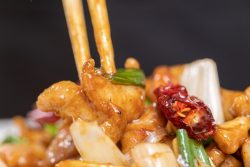
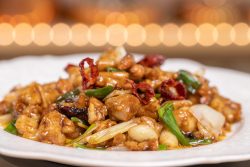
Kung Pao Chicken 🐓 宮保雞丁
Kung Pao Chicken is a popular Chinese dish known for its spicy and savory flavors. Its history is rooted in ancient China and is said to be named after a Qing Dynasty official, Ding Baozhen, who was also known as Kung Pao. While the dish has evolved over time, it has remained a favorite in Chinese cuisine.
Legend has it that Kung Pao Chicken originated in the Sichuan province of China during the late 19th century. Ding Baozhen, a high-ranking government official, was known for his love of food and his penchant for spicy dishes. The story goes that Ding Baozhen would frequently request his chef to create a special dish that combined his favorite ingredients and flavors.
The chef, wanting to please Ding Baozhen, created a dish that featured diced chicken, peanuts, and a medley of vegetables. He stir-fried these ingredients together with a spicy sauce made from chili peppers, Sichuan peppercorns, soy sauce, vinegar, and other seasonings. The resulting dish was named Kung Pao Chicken in honor of Ding Baozhen.
Kung Pao Chicken gained popularity not only because of Ding Baozhen’s endorsement but also because of its delicious taste and satisfying combination of flavors. Over time, the dish spread beyond the Sichuan province and became a staple in Chinese cuisine.
The dish’s key ingredients, such as diced chicken, peanuts, and vegetables, remain consistent in most variations of Kung Pao Chicken. However, different regions and chefs have added their own twists to the recipe. Some variations may include additional ingredients like water chestnuts, bell peppers, or even dried chili peppers for an extra spicy kick.
Kung Pao Chicken made its way to the United States in the early 20th century with Chinese immigrants. It quickly became a popular dish in Chinese-American restaurants and gained recognition among Western diners for its bold flavors and satisfying combination of textures.
Today, Kung Pao Chicken can be found on the menus of Chinese restaurants worldwide, offering a tantalizing blend of spicy, sweet, and savory flavors. It has become one of the most well-known and beloved Chinese dishes, loved for its rich history and delicious taste.
And here is how we do it.
Ingredients:
2 chicken legs
Spring onion
Leek
Garlic
Peanuts
Ginger
Chili
Sichuan pepper (also called Chinese pepper)
Salt pepper
Oil
Water
Corn starch
Light soy sauce
Dark soy sauce
Cooking wine
Vinegar
And sharpen your knife and get ready chef 👨🍳
Cut the spring onion in 1 cm pieces
Cut leek in 1 cm pieces
Cut ginger and garlic
Make the sauce:
15ml cooking wine, if you use stronger alcohol like sake or vodka use 5ml
5ml dark soy sauce
(If you use soya sauce you don’t need to use dark soy sauce since it will color the sauce the same way as dark soy sauce do)
10ml light soy sauce
3ml Vinegar (chinese or Japanese)
4ml sugar
1ml black/white pepper
5ml corn starch
1/2 dl water
Mix it all well and the sauce is ready.
Cut the chicken legs in cubes, you don’t need to remove the skin.
Marinate the chicken
Pepper
1ml dark soy sauce
2 teaspoon light soy sauce
1 teaspoon cornstarch
1 tablespoon vegetable oil
Mix it gently together.
Roast the peanuts
1/2 dl oil for roasting the peanuts
Fry them in hot oil a few minutes- and then remove them
Fry the chicken meat. Use hot oil around 160C
Remove when almost done (80 to 90%)
Take 1 tablespoon fresh oil and fry chili and Sichuan. When the oil has started to get red from the chili add the ginger, garlic and leek.
Add nuts
After a few minutes add the chicken meat in, and when mixed together well add the sauce.
Last thing in is the spring onions.
Well done.
A lovely traditional chinese dish.
原料:
2 雞腿
蔥
韭蔥
蒜
花生
姜
辣椒
花椒(又稱花椒)
椒鹽
油
水
玉米澱粉
生抽
老抽
料酒
醋
如何操作
並磨好刀,準備好廚師👨🍳
將蔥切成1厘米的段
將韭菜切成1厘米的段
切薑和大蒜
做醬汁:
15毫升料酒,如果你用清酒或伏特加等烈性酒,用5毫升
5毫升黑醬油
(如果你用醬油,你不需要用老抽,因為它會像老抽一樣給醬汁上色)
10毫升生抽
3毫升醋(中國或日本)
4毫升糖
1毫升黑/白胡椒
5毫升玉米澱粉
1-1/2 分升水
混合均勻,醬汁就準備好了。
雞腿切塊,不用去皮。
醃製雞肉
胡椒
1毫升黑醬油
2茶匙生抽
1茶匙玉米澱粉
1湯匙植物油
輕輕地混合在一起。
炸花生
1/2 分升油炸花生
在熱油中炸幾分鐘-然後將它們取出
炒雞肉使用160C左右的熱油
快速翻炒,炒至8-9成熟出锅。
取 1 湯匙新鮮油,炒辣椒和花椒。當辣椒和花椒炒出香味時,加入生薑、大蒜和韭葱。
幾分鐘後加入雞肉,混合均勻後加入醬汁。
最後添加堅果和小香蔥。
一道非常好吃傳統中國菜。
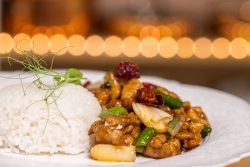
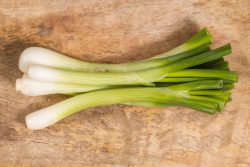
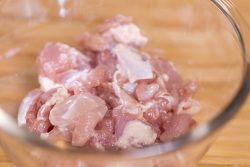


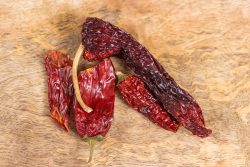
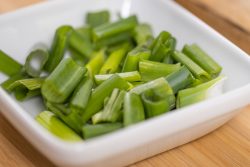
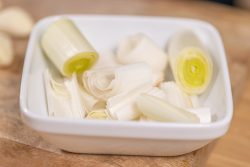
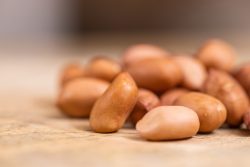

Shopping link


